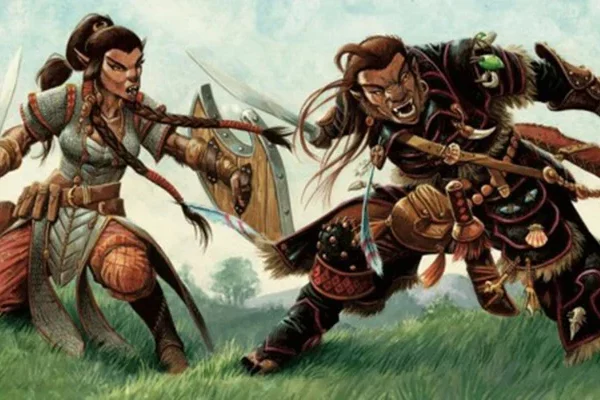Even monsters get a proficiency bonus in D&D, and that bonus gets bigger as the level of the character goes up. Good so far, right?
But it’s not added to every throw, and figuring out how to calculate it and when to add it can be hard.
This guide will go into more detail about what that proficiency bonus is and how to use it.
- What Is a Proficiency Bonus?
- How to Calculated Proficiency Bonus?
- When Do You Use It?
- Things You Do NOT Use Your Proficiency Bonus For?
- Is Proficiency Bonus Added to Damage?
- What Happens if You Don’t Have Proficiency With a Skill?
- Can You Choose to Not Use Your Proficiency Bonus?
- How Does Multiclassing Affect Proficiency Bonus?
What Is a Proficiency Bonus?
In Dungeons and Dragons, a character’s proficiency bonus is a bonus added to skill checks, saving throws, and attacks for skills they are good at.
At first glance, it may not be clear how this bonus is different from the way a character’s abilities are changed.
The biggest difference is that the bonus only comes into play in certain situations. When the character does something that requires intelligence, an intelligence modifier is added.
However, a proficiency bonus is only added if the character has added proficiency for the skill or tool that is needed.
This means that the character is good at this action because of their class or race, or that they have spent more time training and leveling up this skill.
For example, a rogue will be good at using tools used by thieves, while a bard will be good at using musical instruments.
In a battle between the two bands, the bard will have the upper hand. In a heist with a lot at stake, the crook will have the upper hand.
For the game, you call this one-of-a-kind advantage the “proficiency bonus.” This is a number of points that will be added to the player’s roll whenever their character is doing something they are especially good at.
The Player’s Handbook also says:
“Your proficiency bonus can’t be added to a single die roll or other number more than once. For example, if two different rules say you can add your proficiency bonus to a Wisdom saving throw, you nevertheless add the bonus only once when you make the save.”
How to Calculated Proficiency Bonus?
It’s easy to figure out how much of a bonus a character gets because their proficiency bonus is tied to their level.
All level 1 characters, no matter what class or race they are, get a +2 bonus to their skills. The bonus goes up to +3 at level 5. It keeps going up until level 17, when it reaches +6.
Adding the Proficiency Bonus to a Roll
Add the ability modifier and the proficiency bonus to the dice to figure out how many points a roll is worth.
For instance, let’s say you have a level 3 elf with a wisdom of 16 and a perception check roll of 11. Here’s how to figure that out:
11 (base roll) + 3 (Wisdom modifier) + 2 (proficiency bonus) = 16
Even if the character has two or more skills that would help them in this action, you only add the bonus once.
The only time this doesn’t apply is when a character has skills based on their class. In that case, the bonus for being good at something is doubled.
Most of the time, this happens to rogues or bards who can use an expertise feat on one or two skills, but other characters can also have expertise in certain situations.
For example, a draconic sorcerer who talks to another dragon of the same type gets an expertise feat in charisma.
But these things don’t happen very often, and most of the time it’s up to you as the GM to decide what to do.
Multiclass Proficiencies
In D&D, skills are mostly determined by class. But what if your character has more than one class?
In this case, the bonus from the proficiency is based on the character’s overall level, not the level of the class from which the bonus comes.
So, a character who has more than one class and is a level 5 monk and a level 3 rogue has an overall level of 8.
That means that whether they use a monk class proficiency or a rogue class proficiency, their proficiency bonus is +3.
When Do You Use It?
The proficiency bonus only comes into play when the character is trying to do something they are good at. That includes all of the following:
- Attack rolls are made with weapons that the character knows how to use or spells that the character knows how to cast.
- Ability checks that use tools or skills that the character is good at. Saving throws that use skills or abilities that the character is good at.
- For example, a character with an athletics proficiency will get a proficiency bonus whenever they do something that requires athletic skill.
Say you have two people walking through a forest. One is a ranger who is slim and quick. The other one is a huge barbarian.
As they walk, they come across a big hole. They decide that it would take too long to walk around it, so they want to jump over it instead.
Let’s say that they both have the same strength modifier for the sake of this example.
But the ranger, who is good at athletics and is therefore better at long jumps, would get a proficiency bonus on top of their strength modifier here.
On the other hand, the barbarian will have to just take a leap of faith.
Don’t Add a Proficiency Bonus to Damage or Healing Throws
You can add the bonus to attacks, saves, and skill checks, but not to damage or healing throws.
The only thing that changes as a character gets better at a skill is their chance of succeeding.
It doesn’t add to how much damage you do when you attack or how much HP you get back when you heal.
Things You Do NOT Use Your Proficiency Bonus For?
We already talked about when to add the skill bonus. But what about the other way around?
Even though it’s tempting to add your proficiency bonus to everything, here are a few common times when you shouldn’t:
- Armor class
- Damage
- Healing
- Skills, weapon, tools, etc you’re pretty sure you should be proficient with
- Using it more than once per roll
Your proficiency bonus can’t be added to a single die roll or other number more than once… If a circumstance suggests that your proficiency bonus applies more than once to the same roll or that it should be multiplied more than once, you nevertheless add it only once, multiply it only once, and halve it only once.
Page 12, Dungeons & Dragons Players Handbook 5th Edition.
Is Proficiency Bonus Added to Damage?
No, you don’t add your bonus for being good at something to your damage. Not weapon damage, not spell damage – just nope.
But in rare cases, you can add your proficiency bonus to damage rolls made by animals or magical creatures you control. The Players Handbook gives two examples of this:
- a Wizard’s Corpse Servant (in the School of Necromancy Arcane Tradition)
- a Ranger’s Guide for Rangers (in the Beast Master archetype)
What Happens if You Don’t Have Proficiency With a Skill?
All that happens is that you don’t get your bonus for being good at something. If you don’t know how to use a weapon, spell, skill, or saving throw well, you don’t have a disadvantage.
Can You Choose to Not Use Your Proficiency Bonus?
No, nothing in the rules says that you don’t have to use your proficiency bonus.
If you want to do worse on a roll, you could use a weapon, tool, or skill you don’t know how to use well.
If you really want to mess up an attack, all you have to do is close your eyes during a fight. The real question is why you would want to do that.
How Does Multiclassing Affect Proficiency Bonus?
The short answer is: no, it doesn’t! The bonus you get for being good at something is based on your total level, not just your level in one class.
Playing a 4th-level Sorcerer with 2 levels of Barbarian? Your total level is 6, so you get the +3 bonus to proficiency that comes with being a 6th-level character.









